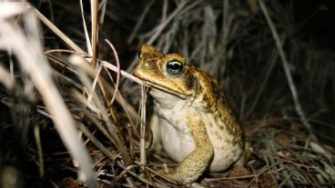
Researchers Mike Letnic (UNSW), Tim Dempster (University of Melbourne)
Jonathan Webb (University of Technology Sydney), Tim Jessop (Deakin University), Ben Feit (University of Western Sydney)
Impacts and spread of cane toads. The introduction of cane toads into Australia in 1935 is one of the nation’s worst ecological tragedies. Cane toads are toxic to many of the native predators that attack them. Consequently, the invasion of cane toads has devastated populations of goannas, freshwater crocodiles, snakes and quolls across the continent.
Cane toads also prey heavily upon dung beetles. Dung beetles were introduced to Australia to improve nutrient cycling in rangeland ecosystems and disrupt the life cycles of livestock parasites. However, predation by cane toads has reduced the important ecosystem services that dung beetles provide for the environment and pastoral industry. Cane toads have been nothing short of disastrous for the Australian environment.
At present, cane toads have occupied about ~2000 000 km2 (over 25%) of Australia and continue to invade west and south into increasingly drier regions. While most people think of cane toads as being tropical animals, most of the area that cane toads have invaded or are predicted to invade has a semi-arid or arid climate.
Cane toads Achilles Heel. Cane toads cannot survive for more than three days during periods of dry conditions that normally prevail in arid Australia without access to water. Natural sources of water are normally scarce in arid regions. However, dams created by pastoralists that serve as reservoirs for bore-water, have dramatically increased the availability of water in naturally parched semi-arid landscapes. Dams, therefore, provide a network of refuge habitats or “invasion hubs” in which toads congregate during dry seasons and visit on an almost daily basis.
Excluding cane toads from water by using an alternative type of reservoir to dams is a practical approach to reduce cane toad populations. Dams could be fenced to exclude toads, or different types of reservoirs such as closed tanks which do not allow toads to access water could be used as alternative types of reservoirs to dams. Although each of the approaches to control cane toads we have demonstrated has its pros and cons, both the fencing of dams or the using of tanks as an alternative to dams have the potential to be used in landscape-scale programs to control cane toads. Importantly for the practical application of these findings, the approaches we have devised do not impinge on the ability of livestock to obtain water, because in most situations in northern Australia livestock drink from troughs not the dams themselves. Also, the native fauna of arid Australia are arid adapted and thus unlike cane toads are not dependent or unduly impacted by exclusion from artificial water sources.
Excluding toads from water could be conducted strategically to prevent their spread. Fencing the thousands of dams that exist across Australia to exclude cane toads is a daunting and prohibitively expensive prospect. However, using simulations we have shown that a practical and cost-effective approach to control cane toads would be to strategically create “toad breaks” to disrupt the network of refuge habitats available for toads. Just like a fire-break can contain a bush-fire by preventing its spread by denying fuel to the fire, toad breaks could be established in areas distant from natural sources of water in places where it would be feasible to exclude toads from water and establish water-less tracts of land which toads could not traverse without perishing. Control of toads at invasion hubs could be conducted reactively to control established populations or prevent the spread of toads by rendering invasion hubs unsuitable for colonization ahead of the invasion front.
The map on the right shows the predicted range of toads in semi-arid and arid Australia based on their physiological limits (grey). Toads can only live in the grey area if they have regular access to water. The coloured areas represent the areas made available to toads by natural sources of water (blue) and artificial sources of water (red). Toads can be excluded from the areas shaded in red by restricting their access to artificial water.
